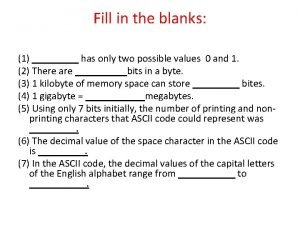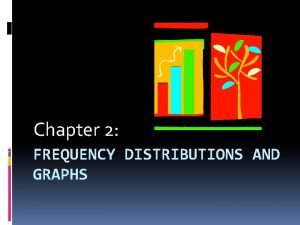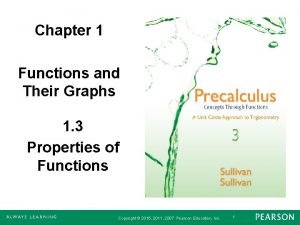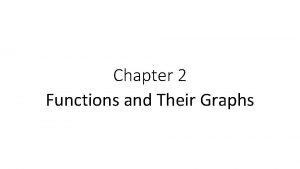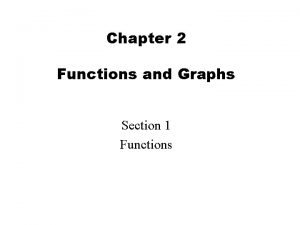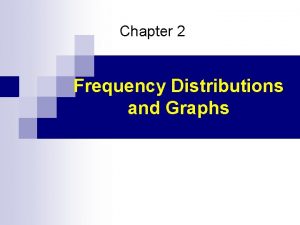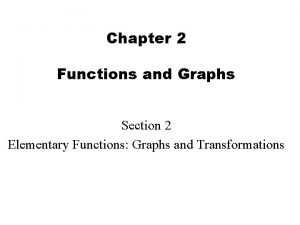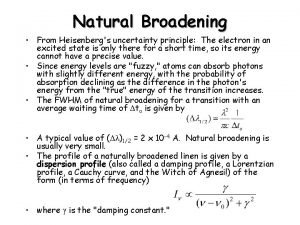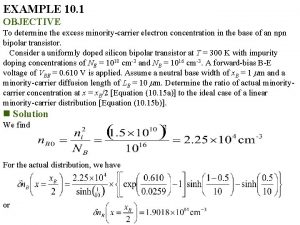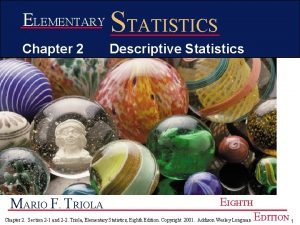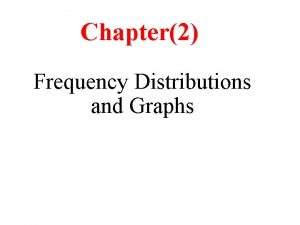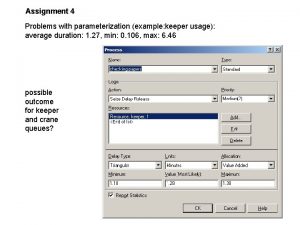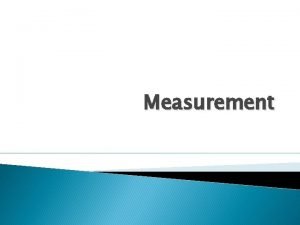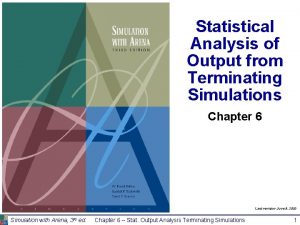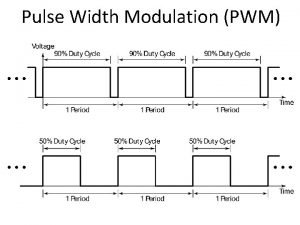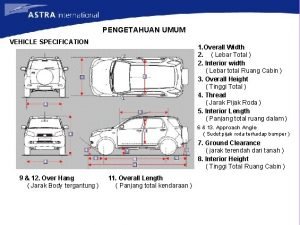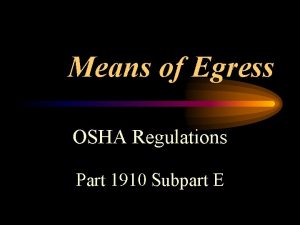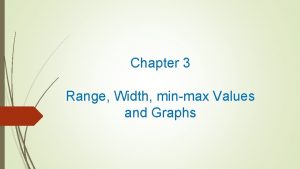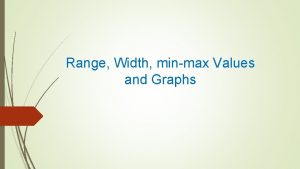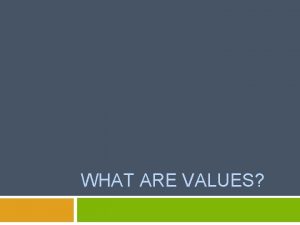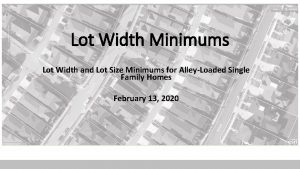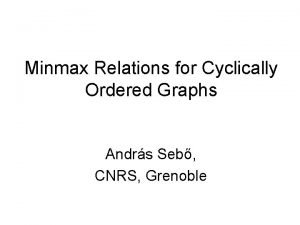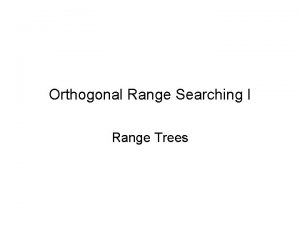Chapter 3 Range Width minmax Values and Graphs
























































































- Slides: 88

Chapter 3 Range, Width, min-max Values and Graphs

Range: The Range is the difference between the lowest and highest values. Example: In {4, 6, 9, 3, 7} the lowest value is 3, and the highest is 9.

Class Width = (x - y) / n Where, x = Maximum Value y = Minimum Value n = Number of Classes Calculate class width for 3 data items having a maximum value of 9, minimum value of 5. Solution: Class Width = (x - y) / n = (9 - 5) / 3 = 1. 333


Frequency In statistics the frequency (or absolute frequency) of an event is the number of times the event occurred in an experiment or study. These frequencies are often graphically represented in histograms.

Histogram A histogram is a chart that shows frequencies for equal width intervals of values of a metric variable. A histogram is a graphical representation that organizes a group of data points into user-specified ranges. It is similar in appearance to a bar graph. The histogram condenses a data series into an easily interpreted visual by taking many data points and grouping them into logical ranges.

Example of a Histogram:



Class Work: Let us assume that we have 20 workers and they are installing different number of (let us say cars) weekly. Each worker assemble different numbers. Let us find the min-max numbers, range, width of the distribution. The let us draw the histogram of the distribution.







The minimum value is 20 cars and the maximum value is 40 cars Range=highest value – Lowest Value Range is 40 -20=20 into interval scale. İn order to find the width we need to classify the observations





Number of Cars Frequency 20 -25 4 26 -30 5 31 -35 2 36 -40 9 Total 20

Width= Range/The Number of Classes Width= 20/4= 5

The Percentage and Cumulative Number of Cars Frequency Percentage Cumulative 20 -25 4 20 20 26 -30 5 25 45 31 -35 2 10 55 36 -40 9 45 100 Total 20 100 -- Let us calculate The Weekly Average We need the middle value for each classes (20+25)/2=22, 5 (26+30)/2=28 (31+35)/2=33 (36+40)/2=38

Number of Cars Mid Classes Frequency Percentage Cumulative 20 -25 22, 5 4 20 20 26 -30 28 5 25 45 31 -35 33 2 10 55 36 -40 38 9 45 100 20 100 -- Total (22, 5 x 0. 2)+(28 x 0. 25)+(33 x 0. 10)+(38 x 0. 45) = 31. 9 = 32 Cars

In order the lengths are: 1, 1, 1, 4, 4, 5, 5, 5, 6, 7, 8, 8, 8, 9, 9, 9, 10, 11, 12, 13, 14, 15, 16, 16, 17, 17, 18 The smallest value (the "minimum") is 1 cm The largest value (the "maximum") is 18 cm The range is 18− 1 = 17 cm Let us say we want about 5 groups. Divide the range by 5: 17/5 = 3. 4 Then round that up to 4 Pick a starting value that is less than or equal to the smallest value. Try to make it a multiple of the group size if you can. In our case a start value of 0 makes the most sense

Starting at 0 and with a group size of 4 we get: 0, 4, 8, 12, 16 Write down the groups, include the end value of each group (must be less than the next group): The last group goes to 19 which is greater than the largest value. That is OK: the main thing is that it must include the largest value.

Line Graph With One Variable







Line Graphs With two Variables







Bar chart (or graph): A bar chart is a graph which uses parallel rectangular shapes to represent changes in the size, value, or rate of something or to compare the amount of something relating to a number of different countries or groups.

Bar Graph With One Variable







Bar Graph With Two Variables







Pie Chart: A pie chart (or a circle chart) is a circular statistical graphic which is divided into slices to illustrate numerical proportion. In a pie chart, the arc length of each slice (and consequently its central angle and area), is proportional to the quantity it represents.









Static Relation Between Two Variables (Scatter Graph)

Scatter plots (also called scatter graphs) are similar to line graphs. A line graph uses a line on an X-Y axis to plot a continuous function, while a scatter plot uses dots to represent individual pieces of data. In statistics, these plots are useful to see if two variables are related to each other. For example, a scatter chart can suggest a linear relationship (i. e. a straight line).

Suppose we have 15 consumers; their monthly income and consumptions are given in the table






Week estimation Strong estimation

EViews













 Line chart
Line chart Minmax java
Minmax java Minimax regret
Minimax regret Minmax normalization
Minmax normalization State graph in software testing
State graph in software testing Graphs that enlighten and graphs that deceive
Graphs that enlighten and graphs that deceive Domain and range for graphs
Domain and range for graphs Graphs that compare distance and time are called
Graphs that compare distance and time are called End behavior chart
End behavior chart Machiavellian personality
Machiavellian personality An individual's enduring tendency to feel
An individual's enduring tendency to feel As compared to long-range forecasts, short-range forecasts
As compared to long-range forecasts, short-range forecasts Blood gas values
Blood gas values Steps of image processing
Steps of image processing Identify the range of values for x.
Identify the range of values for x. Western values vs eastern values
Western values vs eastern values What are the two possible values of a bit
What are the two possible values of a bit Concept of values
Concept of values Chapter 2 frequency distributions and graphs answers
Chapter 2 frequency distributions and graphs answers Chapter 1 functions and their graphs
Chapter 1 functions and their graphs Chapter 2 functions and graphs
Chapter 2 functions and graphs Chapter 2 functions and their graphs answers
Chapter 2 functions and their graphs answers Chapter 2: frequency distributions and graphs answers
Chapter 2: frequency distributions and graphs answers Chapter 1 graphs functions and models answers
Chapter 1 graphs functions and models answers Chapter 2 functions and graphs
Chapter 2 functions and graphs Length width and height of a rectangular prism
Length width and height of a rectangular prism Window width ct
Window width ct The representation of an object on a plane surface
The representation of an object on a plane surface It encloses volume height width and depth
It encloses volume height width and depth Rotational spectral lines
Rotational spectral lines Natural broadening
Natural broadening Sepal.width
Sepal.width Chapter 4 values, attitudes and job satisfaction
Chapter 4 values, attitudes and job satisfaction Organizational behavior chapter 5
Organizational behavior chapter 5 Chapter 5 personality and values
Chapter 5 personality and values Chapter 22 ethics and values
Chapter 22 ethics and values Trubyte denture teeth
Trubyte denture teeth Product mix of samsung
Product mix of samsung Runtomrun
Runtomrun Product mix
Product mix Product line width
Product line width Nccer basic stair layout
Nccer basic stair layout Strap major connector
Strap major connector Length x width x height
Length x width x height Geogg
Geogg Lower class boundary
Lower class boundary Tire track width
Tire track width Perimeter definition
Perimeter definition Cin.width
Cin.width Emitter injection efficiency formula
Emitter injection efficiency formula Characteristics of inferential statistics
Characteristics of inferential statistics What is the class width for the given class (28-33)?
What is the class width for the given class (28-33)? Roughness width cutoff
Roughness width cutoff What is the bradshaw model
What is the bradshaw model Define biological width
Define biological width Arena half width
Arena half width Length x width x height
Length x width x height Standard road width
Standard road width Celestial axis hair
Celestial axis hair Product line width
Product line width Product mix width
Product mix width Computer system clock
Computer system clock Pwm modulation definition
Pwm modulation definition Duty cycle formula
Duty cycle formula Goods-to-services continuum
Goods-to-services continuum Industrial standard architecture
Industrial standard architecture Rms spectral width
Rms spectral width Pcb designprozess
Pcb designprozess Multiple pulse width modulation
Multiple pulse width modulation Product mix vs product line
Product mix vs product line Cavity class 4
Cavity class 4 Lwr line width roughness
Lwr line width roughness Width of the classroom in pace
Width of the classroom in pace Class width histogram example
Class width histogram example Gv black cavity classification
Gv black cavity classification Area = length x width
Area = length x width L quantity
L quantity Xilinx parameterized macros
Xilinx parameterized macros Cp chapter 2
Cp chapter 2 Html
Html What are weight, mass, and volume?
What are weight, mass, and volume? Protraction of scapula
Protraction of scapula How to find the length of confidence interval
How to find the length of confidence interval Half width arena
Half width arena Putter stance setup
Putter stance setup What is pulse width modulation
What is pulse width modulation Posterior vibrating line
Posterior vibrating line Overall width of vehicle
Overall width of vehicle Osha part 1910
Osha part 1910
















